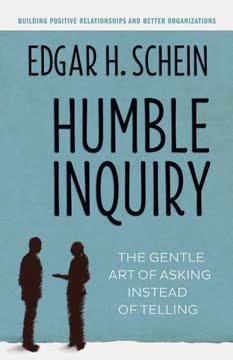Key Takeaways
1. Organizational culture is a complex system of shared assumptions
Culture is an abstraction, yet the forces that are created in social and organizational situations deriving from culture are powerful.
Culture is multifaceted. It encompasses observable artifacts, espoused values, and deep-seated assumptions that guide behavior within an organization. These elements form a cohesive system that provides meaning, stability, and predictability to group members.
Culture has several key characteristics:
- Structural stability: It persists even when group members change
- Depth: It operates largely outside of conscious awareness
- Breadth: It influences all aspects of group functioning
- Patterning: It integrates various elements into a coherent whole
Culture is learned through shared experiences as groups solve problems of external adaptation and internal integration. It represents the accumulated learning of a group, reflecting what has worked well enough to be considered valid and taught to new members.
2. Leaders shape culture through primary embedding mechanisms
The most powerful mechanisms that founders, leaders, managers, and parents have available for communicating what they believe in or care about is what they systematically pay attention to.
Leaders embed culture through behavior. Their actions, rather than their words, communicate the most important values and assumptions to organization members. Six primary embedding mechanisms are particularly influential:
- What leaders pay attention to, measure, and control
- How leaders react to critical incidents and crises
- How leaders allocate resources
- Deliberate role modeling, teaching, and coaching
- How leaders allocate rewards and status
- How leaders recruit, select, promote, and excommunicate
These mechanisms work together to reinforce cultural values and assumptions. For example, a leader who consistently asks about safety issues in meetings, reacts strongly to safety violations, allocates resources to safety programs, and rewards safe behavior is likely to create a strong safety culture.
3. Secondary articulation mechanisms reinforce cultural values
In a young organization, design, structure, architecture, rituals, stories, and formal statements are cultural reinforcers, not culture creators.
Formal structures support culture. While less powerful than primary embedding mechanisms, secondary articulation mechanisms can reinforce cultural messages if they are consistent with leader behavior. These include:
- Organizational design and structure
- Systems and procedures
- Rites and rituals
- Design of physical space and buildings
- Stories about important events and people
- Formal statements of philosophy or values
These mechanisms become more important as an organization matures, often outlasting the founders and becoming constraints on future leaders. For example, a company's annual rituals, office layout, or standard operating procedures can continue to reinforce cultural values long after they were first established.
4. Culture emerges through group formation and shared experiences
The strength and stability of culture derives from the fact that it is group based—that the individual will hold on to certain basic assumptions to ratify his or her membership in the group.
Groups develop culture through shared learning. As new groups form, they must solve basic problems of survival and integration. This process involves:
- Developing a shared language and conceptual categories
- Defining group boundaries and criteria for inclusion
- Establishing norms for intimacy, friendship, and love
- Defining and allocating power and status
- Developing rules for rewards and punishments
- Creating explanations for the unexplainable
Through these experiences, group members develop shared assumptions about how to perceive, think, and feel in relation to problems they face. These assumptions become the core of the group's culture, providing stability and meaning to members.
5. Founders' beliefs and values are the initial source of organizational culture
Founders not only choose the basic mission and the environmental context in which the new group will operate, but they choose the group members and thereby shape the kinds of responses that the group will make in its efforts to succeed in its environment and to integrate itself.
Founders imprint their assumptions. The initial culture of an organization is largely shaped by the founders' beliefs, values, and assumptions. Founders typically have strong ideas about:
- The organization's mission and strategy
- Appropriate means to achieve goals
- Criteria for measuring success
- How to structure the organization
- What kind of people to hire
These assumptions are tested as the organization faces challenges. If they lead to success, they become deeply embedded in the culture. For example, Sam Steinberg's assumptions about customer service and visible management shaped Steinbergs' culture for decades.
6. Culture evolves as organizations face external and internal challenges
As organizations grow and evolve, so do their cultures.
Adaptation drives cultural change. While founders' assumptions provide the initial basis for culture, organizations must continue to adapt to survive. Cultural evolution occurs through:
- Learning from success and failure in solving problems
- Integrating new members with different perspectives
- Responding to changes in the external environment
- Dealing with internal growth and differentiation
As organizations mature, subcultures often emerge in different functional areas or levels of the hierarchy. Managing the interplay between these subcultures becomes a key leadership challenge. For instance, DEC's engineering-driven culture became problematic as the company grew and faced increasing market pressures.
7. Deciphering culture requires understanding artifacts, values, and assumptions
If you do not decipher the pattern of basic assumptions that may be operating, you will not know how to interpret the artifacts correctly or how much credence to give to the espoused values.
Culture operates at multiple levels. To truly understand an organization's culture, one must examine:
- Artifacts: Visible structures and processes
- Espoused values: Ideals, goals, and aspirations
- Basic underlying assumptions: Unconscious, taken-for-granted beliefs
Deciphering culture involves:
- Observing artifacts and behaviors
- Identifying espoused values through interviews and documents
- Inferring underlying assumptions by looking for patterns and inconsistencies
This process requires careful observation, questioning, and analysis. It's particularly important to look for areas where espoused values and observable behavior don't align, as these often reveal deeper cultural assumptions.
8. Cultural alignment is crucial for organizational effectiveness
When we examine the formation of groups that are initially multinational, such as cross-national mergers like that of British Petroleum and Amoco or joint ventures between companies from different countries, we see how disagreement on this higher level of abstraction can make group formation and performance extremely difficult.
Misalignment causes problems. When subcultures or national cultures clash within an organization, it can lead to:
- Communication breakdowns
- Conflict and mistrust
- Inefficiency and poor performance
- Difficulty in implementing change initiatives
Leaders must work to align:
- The cultures of different functional areas (e.g., marketing vs. engineering)
- The cultures of different hierarchical levels
- The organization's culture with its strategy and environment
Achieving alignment often requires creating "cultural islands" where members can explore differences and develop shared understanding. This is particularly important in multinational or cross-cultural organizations.
9. Leadership and culture are two sides of the same coin
Culture creation and management are the essence of leadership and make you realize that leadership and culture are two sides of the same coin.
Leaders shape and are shaped by culture. The relationship between leadership and culture is dynamic and reciprocal:
- Leaders create cultures when they create groups and organizations
- Once cultures exist, they determine the criteria for leadership and influence who will or will not be a leader
- If cultures become dysfunctional, leadership is required to perceive the functional and dysfunctional elements of the existing culture and to manage cultural evolution
Effective leaders must:
- Understand the existing culture
- Align the culture with the organization's goals and environment
- Embed and reinforce cultural values through their actions
- Manage cultural change when necessary
This requires a deep understanding of cultural dynamics and the ability to work with culture as both a tool and a constraint.
Last updated:
FAQ
What's Organizational Culture and Leadership about?
- Focus on Culture and Leadership: The book explores the relationship between organizational culture and leadership, showing how leaders shape and are shaped by the culture.
- Cultural Dimensions: It defines culture at various levels, including macrocultures, organizational cultures, subcultures, and microcultures, and how these layers interact.
- Practical Insights: Edgar H. Schein provides frameworks and case studies to help readers understand and manage cultural dynamics effectively.
Why should I read Organizational Culture and Leadership?
- Understanding Organizational Dynamics: Essential for grasping how culture affects organizational effectiveness and employee behavior.
- Leadership Development: Offers insights into how leaders can create, embed, and evolve culture, valuable for current and aspiring leaders.
- Real-World Examples: Uses case studies from companies like DEC and Ciba-Geigy to illustrate key concepts, making theories relatable and applicable.
What are the key takeaways of Organizational Culture and Leadership?
- Culture Shapes Behavior: Culture is a powerful force influencing how individuals perceive, think, and act within an organization.
- Leadership's Role: Leaders are architects of culture, responsible for initiating and managing cultural change to align with organizational goals.
- Complexity of Culture: Culture is multifaceted and evolves through shared experiences, making it crucial for leaders to understand its dynamics.
How does Edgar H. Schein define organizational culture in Organizational Culture and Leadership?
- Cultural Definition: Culture is "a pattern of shared basic assumptions learned by a group as it solved its problems of external adaptation and internal integration."
- Learning Process: Culture evolves through social learning and is taught to new members as the correct way to perceive and act.
- Stability and Change: While culture provides stability, it can change when leaders actively manage cultural evolution.
What are the three levels of culture described in Organizational Culture and Leadership?
- Artifacts: Visible elements like office layout and dress code, easy to observe but difficult to interpret.
- Espoused Values: Stated values and norms that the organization claims to uphold, which may not always align with actual behavior.
- Basic Underlying Assumptions: Deeply embedded beliefs that drive behavior within the organization, often operating unconsciously.
What is the role of leaders in managing culture change according to Organizational Culture and Leadership?
- Change Agents: Leaders must recognize when cultural elements are dysfunctional and take steps to initiate change.
- Creating Psychological Safety: Effective leaders create an environment where employees feel safe to express concerns and suggest changes.
- Embedding New Values: Leaders are responsible for embedding new values and behaviors through role modeling, teaching, and reinforcement mechanisms.
How do leaders embed their beliefs and values in organizational culture according to Organizational Culture and Leadership?
- Role Modeling: Leaders demonstrate desired behaviors to employees through deliberate role modeling, teaching, and coaching.
- Reward Systems: Aligning rewards and recognition with specific behaviors reinforces the cultural values leaders wish to promote.
- Selection Processes: Leaders influence culture by selecting, promoting, and excommunicating individuals based on their alignment with desired cultural values.
What are the primary embedding mechanisms discussed in Organizational Culture and Leadership?
- Attention and Measurement: Leaders communicate priorities through what they pay attention to and measure regularly, reinforcing specific cultural values.
- Reaction to Incidents: Leaders' responses to critical incidents reveal their underlying assumptions and shape organizational norms.
- Resource Allocation: How leaders allocate resources signals what is valued within the organization, influencing cultural priorities.
How does Organizational Culture and Leadership address the challenges of multicultural teams?
- Cultural Islands Concept: Temporary settings that allow team members to explore and understand each other's cultural backgrounds without usual constraints.
- Focused Dialogue: Emphasizes dialogue as a means to facilitate understanding and empathy among team members from different cultures.
- Building Common Ground: Creating a safe space for open communication helps multicultural teams find common ground and work effectively together.
What are some examples of cultural change mechanisms in organizations according to Organizational Culture and Leadership?
- Crisis and Scandal: Major crises can trigger cultural change by exposing underlying assumptions and prompting reevaluation of practices.
- Mergers and Acquisitions: Infusion of new leaders and ideas through mergers can lead to significant cultural shifts.
- Technological Changes: New technologies can reshape culture by altering communication patterns and operational processes.
What is the significance of psychological safety in Organizational Culture and Leadership?
- Encourages Open Communication: Allows employees to speak up about issues without fear of retribution, fostering trust and collaboration.
- Facilitates Learning and Growth: When employees feel safe, they engage in learning and experimentation, essential for innovation.
- Reduces Resistance to Change: A psychologically safe environment mitigates resistance to change, as employees are more willing to embrace new ideas.
What are the best quotes from Organizational Culture and Leadership and what do they mean?
- “Culture is a learned solution to making sense of the world.”: Emphasizes that culture is developed through shared experiences and socialization.
- “Leaders are entrepreneurs and the main architects of culture.”: Highlights the proactive role leaders play in shaping and evolving organizational culture.
- “If elements of the culture become dysfunctional, it is the leader’s responsibility to do something to speed up culture change.”: Underscores leaders' accountability in addressing cultural issues that impede effectiveness.
Review Summary
Organizational Culture and Leadership is highly regarded as a comprehensive guide on organizational culture. Readers praise Schein's methodology and practical insights, finding it valuable for understanding and analyzing corporate cultures. While some find the book lengthy and academic in tone, many appreciate its depth and real-world examples. The three-level model of culture (artifacts, espoused values, underlying assumptions) is frequently cited as particularly useful. Critics note the book's verbosity and dated examples, but overall it's considered a must-read for leaders and managers interested in organizational culture.
Similar Books







Download PDF
Download EPUB
.epub digital book format is ideal for reading ebooks on phones, tablets, and e-readers.






